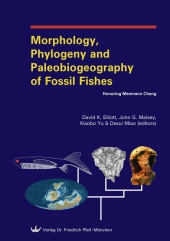 Neuerscheinungen 2010Stand: 2020-01-07 |
Schnellsuche
ISBN/Stichwort/Autor
|
Herderstraße 10
10625 Berlin
Tel.: 030 315 714 16
Fax 030 315 714 14
info@buchspektrum.de |

David K Elliott, John G Maisey, Desui Miao, Xiaobo Yu
(Beteiligte)
Morphology, Phylogeny and Paleobiogeography of Fossil Fishes
Honoring Meemann Chang
Herausgegeben von Elliott, David K; Maisey, John G; Yu, Xiaobo; Miao, Desui
2010. 472 p. w. 13 col. and 194 b&w figs., 14 tables. 245 mm
Verlag/Jahr: PFEIL 2010
ISBN: 3-89937-122-4 (3899371224)
Neue ISBN: 978-3-89937-122-2 (9783899371222)
Preis und Lieferzeit: Bitte klicken
The study of fossil fishes has advanced significantly over the past few years, giving scientists a rare opportunity to understand the origin and early evolution of major vertebrate groups, ranging from the jawless agnathans to piscine gnathostomes (placoderms, acanthodians, chondrichthyans and osteichthyans). This book presents recent findings on the morphology, phylogeny and paleobiogeography of fossil fishes, as a tribute to Professor Meemann Chang for her contributions to paleoichthyology and to the study of early vertebrate evolution.
With a foreword by Dr. Henry Gee (Senior Science Editor of Nature), an introduction, 22 research papers by leading vertebrate paleontologists from 14 countries, and 220 photos and illustrations, this book covers important fossil forms ranging from the Paleozoic to the Cenozoic and reflects research advances based on traditional paleontological methods as well as new techniques such as CT scanning.
For fossil agnathans, a new heterostracan is described from the western U.S., the interrelationships and evolutionary history of anaspids are discussed, and evidence is presented showing that anaspids or anaspid-like agnathans may have had a spiral intestine similar to that of gnathostomes. One paper on acanthodians shows that the enigmatic Machaeracanthus may have had paired pairs of pectoral fin spines and a perichondrally ossified scapulocoracoid. New placoderms from northern Siberia and western Australia are described, and the pectoral fin development in gnathostomes is reviewed based on a revision of previous hypotheses and new fossil arthrodire material. Chondrichthyans are represented by the description of a giant electric ray from the Eocene of Italy, and by new articulated material from the Early Devonian of the Northwest Territories showing that the scale- and spine-based distinctions between acanthodians and chondrichthyans do not account for the diversity that is now apparent. Nine papers on osteichthyans cover wide ranging topics from the cosmine histology of a stem sarcopterygian, to the characters of the stem tetrapod neurocranium, and to new Tertiary osteoglossid fishes. New morphological and phylogenetic information on the snout of Devonian dipnoans and the neurocranium of Powichthys is presented based on CT scanning. An uncrushed specimen of Eusthenopteron enables a revision of the ethmosphenoid morphology bearing on the choana, while a lungfish study indicates that the postcranial anatomy may be an underexploited source of characters for phylogenetic studies. The role of fossils in phylogenetic studies is also examined based on teleost phylogenies. While the link between morphology, phylogeny and paleobiogeography permeates many papers, two papers have a predominant focus on paleoecology and paleobiogeography one reviewing the ecological connections and paleobiogeographic implications of the Jehol Biota, and the other reviewing the South American Devonian vertebrate record, demonstrating the presence of two faunal assemblages of which the earlier one equates with the Malvinokaffric Realm based on invertebrate communities.


